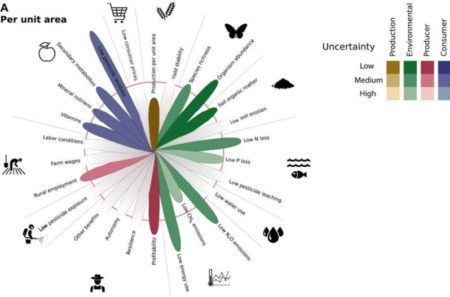But how does it measure up on paper?
If you read my blog at SAIFood.ca, you will notice that GMOs are often the focus. This may come across as opposition to organic. This isn’t the intent. Like GM production, organics are a system of increasingly sustainable agricultural practices, they’re just grown under different measures. Similarly to conventional or GM production, organics have both pros and cons. This week we are reviewing an article from Science Advances “Many shades of gray—The context-dependent performance of organic agriculture” by Verena Seufert and Navin Ramankutty that identifies where organics excel or fall short.
Evaluating Organic
In their paper, Seufert and Ramankutty examined “[w]here does organic agriculture perform well, and where does it not?” They assessed four areas: production, environment, producers and consumers. Using a quantitative scientific literature meta-analysis, they focused on the farm level of organic crops, excluding livestock production. There’s too much information in this paper to address in one blog, so we highlight the key findings. If your interests are piqued, then we recommend you read the full publication at Science Advances.
Measuring up Organic
When it comes to production, organics don’t have the same yield potential as conventional agriculture. Figure 1 shows the organic yield lag at 19-25% below conventional. These lags vary by crop (cereals are high, while forages are low). Even though organic yields aren’t greater than conventional, they may offer stability benefits. Higher organic soil matter can help improve crop conditions during drought and crop rotations that are more diverse can benefit yield stability.

Figure 1: Overall average performance of organic agriculture to conventional agriculture (indicated by the red circle) (Seufert & Ramankutty, 2017)
The organic petal for “Production per unit area” is within the convention average, suggesting it is less productive. Whereas if you look at “Yield stability”, organic production petal is beyond the red circle of conventional, signifying that organic’s yield stability is greater.
Organic production will be beneficial to some and costly to others
It’s generally thought by consumers that organics are environmentally beneficial. When it comes to biodiversity, this is generally true, increasing the organisms across taxa’s by up to 50%. Soil quality also benefits, high carbon content reduces soil erosion while improving soil health and fertility. Tillage, while once a commonly criticized practice of organics is no longer as heavily relied on, as reduced tillage systems are being adopted (US farmers reduced by 41%). Not considering soil as carbon storage to mitigate climate change, per unit of area organic typically has a lower GHG emission.
From Farmers to Consumers, who benefits?
Consumers pay a premium for organics. The high demand and lower supply (compared to conventional) means farmers receive a premium price for organic crops. These higher prices in North America, Europe and India help protect farmers from the risks of price changes, lower yields or crop failure. While these farmers are protected by premiums, 75% of organic farmers are located in low-income countries, often reliant on exporters to reach the distant profits of international organic markets. The sale of organics is beneficial to low-income producers, yet the profits are not linear with producers in developed nations.
When it comes to consumers, the quantitative and meta-analysis data isn’t concise or agreeable about the difference in nutrient content between organics and conventional. They did conclude though that organic plant foods had higher secondary metabolites, vitamins, mineral micronutrients and macronutrients. In addition to having lower levels of pesticide residues. These benefits can be captured by consumers, however, it comes at a premium price (estimated to be 50% more than conventional in the US). As a result, these benefits are beyond some consumers’ food budgets.
Organics looks perfect on paper
There’s no denying, organics looks like a great means of production. So can it be scaled up? Organics is often carried out on marginal land and if given the opportunity to expand onto better arable lands, perhaps productivity could increase. Organics relies on varieties bred for conventional systems and further investment in crop development is needed in order to fully capture potential increases. There’s also the concern that organic production benefits from the pest control of neighbouring conventional farmers. Therefore scaling up organics raises the uncertainty of pest issues and means of control.
Organics is a good means of production for some farmers. But it’s just that, a means of production, not a lifestyle or ideology. When it comes to supporting agriculture, we should support producer choice, and encourage research in organic inputs (including seeds) to compete with conventional. We know that organics alone can’t feed the growing world demands. Therefore we need to remember that organic, conventional and GM production all have a role in food security. Agriculture is made up of many ecosystems which impact society, no single means of production is the silver bullet or Holy Grail to sustainably feeding the world.
Reference:Seufert, V., & Ramankutty, N. (2017). Many shades of gray—The context-dependent performance of organic agriculture. Science Advances, 3(3), e1602638. doi: 10.1126/sciadv.1602638
This blog was reposted with the author’s permission. Please visit SAIFood.ca for more blogs by Dr. Stuart Smyth.
